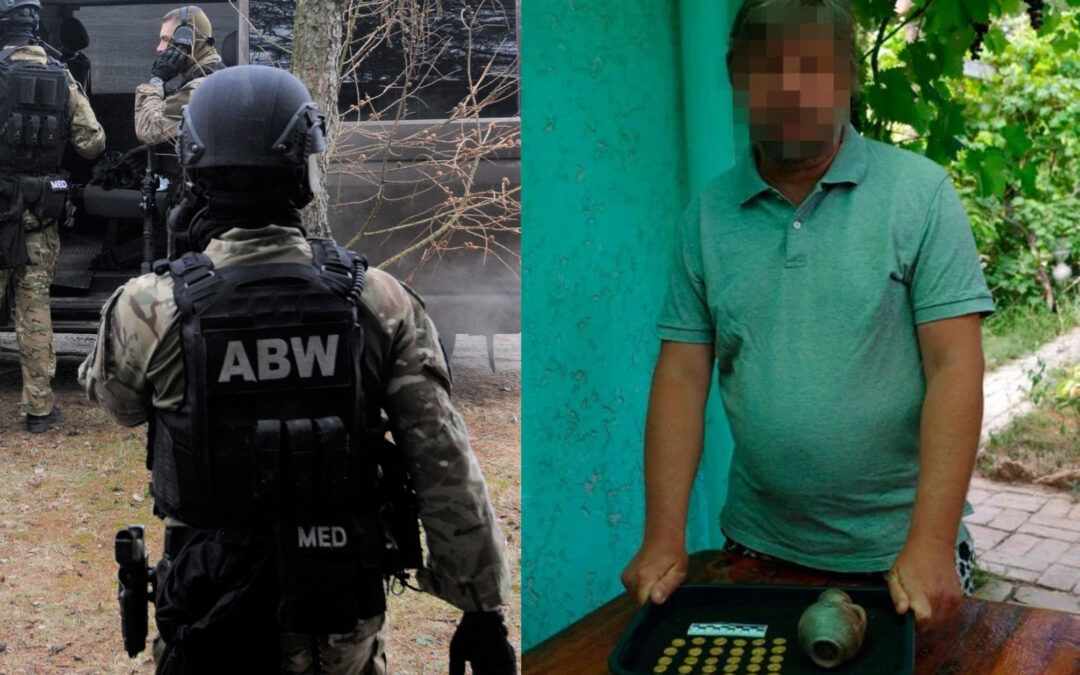Keep our news free from ads and paywalls by making a donation to support our work!

Notes from Poland is run by a small editorial team and is published by an independent, non-profit foundation that is funded through donations from our readers. We cannot do what we do without your support.
A group of detectorists in Poland have uncovered parts of an Enigma machine, a cipher device used by Nazi Germany to encrypt messages. It is likely to have been destroyed and buried by retreating German forces at the end of World War Two.
The find was made on Sobieszewska Island, located next to the city of Gdańsk on Poland’s northern Baltic coast, by members of the Latebra Foundation, which has been conducting research in the area for years with the permission of the local conservation authority and landowners.
One of the foundation’s members, named only as Marta, came across something while scanning the ground with a metal detector. After it was dug up, it turned out to be one of the rotors of an Enigma machine.
That led to further excavation work, which uncovered seven more rotors as well as elements of the casing and other parts of an Enigma machine. They also found field telephones, radio broadcasting equipment and laryngophones (also known as throat microphones) used in German tanks.
Członkowie Fundacji Latebra znaleźli podczas badań na Wyspie Sobieszewskiej w Gdańsku fragmenty niemieckiej maszyny szyfrującej Enigma. Znalezisko potwierdził już zastępca dyrektora ds. merytorycznych Narodowego Muzeum Morskiego.https://t.co/rW4WgUFtGG
— tvn24 (@tvn24) December 14, 2024
Dominik Markiewicz, a member of the Latebra Foundation’s board, believes that the material found indicates that the location was a communications point for retreating German troops at the end of the war, when Soviet forces were advancing into occupied Polish territory.
Sobieszewska Island was an evacuation point for German troops and civilians, thousands of whom gathered there. Markiewicz believes the communications equipment was deliberately destroyed to prevent it from falling into Soviet hands.
That view has been supported by Marcin Westphal, deputy director of the National Maritime Museum in Gdańsk.
“In my opinion, what was found were the remains of an Enigma cipher machine and the remains of a radio station,” he told broadcaster RMF. “When the troops had to retreat or go into captivity, they destroyed this secret, valuable equipment so that it would not fall into the hands of the Soviets.”
Before the war, Gdańsk was known as the Free City of Danzig, existing as a city-state under League of Nations protection. It was one of the first targets attacked by Nazi Germany during the invasion of Poland on 1 September 1939. After the war, the city became part of Poland.
It has not yet been decided where the artefacts will end up. First, a report will be prepared by the provincial conservator’s office, notes local news service Trojmiasto.pl.
The Latebra Foundation – which describes finding an Enigma machine as the “holy grail” of their work – hopes that it can be housed in a museum in Gdańsk itself.
The Enigma machine has particular significance for Poland as it was a group of Polish mathematicians whose work was vital in helping crack the machine’s code. That in turn played an important part in the eventual Allied victory in World War Two.
A new centre is opening this weekend dedicated to the decisive role Polish mathematicians played in cracking the German Enigma code, which played an important part in the Allied victory in WWII https://t.co/nkGPwnLWQi pic.twitter.com/LkgQCaRueO
— Notes from Poland 🇵🇱 (@notesfrompoland) September 21, 2021

Notes from Poland is run by a small editorial team and published by an independent, non-profit foundation that is funded through donations from our readers. We cannot do what we do without your support.
Main image credit: Alessandro Nassiri/Wikimedia Commons (under CC BY-SA 4.0)

Daniel Tilles is editor-in-chief of Notes from Poland. He has written on Polish affairs for a wide range of publications, including Foreign Policy, POLITICO Europe, EUobserver and Dziennik Gazeta Prawna.



















